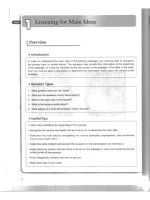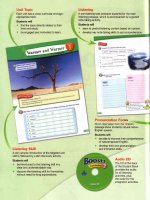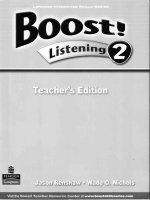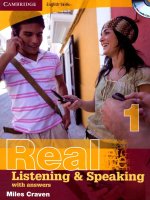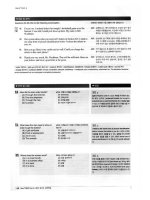Boost listening 1
Bạn đang xem bản rút gọn của tài liệu. Xem và tải ngay bản đầy đủ của tài liệu tại đây (16.12 MB, 72 trang )
ost!
Listenins
li'.
rf
NI
f"o
q
.iason
Renshaw
Published
by
Pearson
Longman
Asia EIJT
20lF
Cornwall
House
Taikoo Place
979 King's
Road
QuarryBay
HongKong
fax +852 2856 9578
email:
www.p earsonlongman.
com
and Associated
Companies
throughout
the world.
@ Pearson
Education
Asia
Limited
2007
All rights
reserved;
no
part
of
this
publication may be
reproduced,
stored
in a
retrieval system,
or
transmitted
in
any
form
or by"any
means,
elect;onic,
meclianical,
photocopying, recording,
or
otherwise
without
the
prior written
permission
of
the
Publishers.
First
published2OOT
Reprinted
2008
Produced
by
Pearson Education
Asia Limited,
Hong
Kong
GCCI02
ISBN- l3: 978-962-00-5873-8
ISBN- 10: 962-00-5873-9
Publisher:
Simon Campbell
Senior
Editor: Howard
Cheung
Project Editor:
Jessica
Balde
Designers:
Iunko
Funaki, Annie
Chan
Illustrator:
Balic Choy
Audio
Production:
David
Pope and
SkyProductions
For
permission
to use copyrighted
images,
we would like
to thank Owill
& Deni
Mclnqre/Corbis
(pb.
5
TR, 12 and
13), @
W Perry Conway/Corbis
(p.
2)), O Ted Streshinsky/Coibis
(p.
2d, @ LWA-DannTardif/Corbis
(p.29),
@ SandroVannini/Corbis
(p.33),
Altrendo
Images
(p.
39), @
Michael
A.
Keller/zefalCorbis
(p.
42), @
Benelux/zefalCorbis
(p.
43), @ Cat
Gwlnn/Corbis
(p.
47), @
Randy Faris/Corbis
(p.
49), @
R H Productions/Robert
HardingWorld
Imagery/Corbis
(p.
52 BL), @
Poppy
Berry/Corbis
(p.
56 BL), @
Tom Stewart/Corbis
(p.
56
BR), @
Rolf Bruderer/Corbis
(p.
57), @
Rick
GomezTCorbis
(p.
S-g), O
enna
peisl
(photonica
Collection)
(p.
63), O
Iose
Luis
Pelaez,
Inc./Corbis
(p.
66
T) @ Eleanor
Bentall/Corbis
(p.
67).
Acknowledgements
Boostl
Listeiring
is dedicated
to a
great family: my
wife Yeona
and son
Jamie,
my
parents
!.ryc_e
and
Diane,
sisters
Naomi and
Kari, uncles
Colin,
Buik and
Deiek, ind
aunts
Alison,
Marion
and Christine.
I d also
like to express
a special
dedication
to
my
grandparents Bruce
and Sylvia
Renshaw
who inspired
me
from birth
with the
desire to dream
and excel.
Here are the
listening
books
for
you
all-just
to
prove
I did
listen
.
Iason
Renshaw
The
Publishers
would also
like to thank
the
following teachers
for their
suggestions
and
comments
on
this course:
Tara
Cameron,
Rosanne Cerello,
Nancy Chan,
Chang
fi Ping,
Ioy
Chao,
Jessie
Chen,
Josephine
Chen,
ChiangYing-hsueh,
Claire Cho,
Cindy Chuang,
Linda Chuing,
Chueh
Shiu-wen,
Mark
de
Boer, Mieko
Hayashida,
Diana
Ho, Lulu
Hsu,
Eunice
lung,
Hye
ni Kim,Jake
Kimball,
Joiie
Lai, Carol
Lee, Elaine
Lee,
Melody
Lee, Peggy
Li,
Esther
Lim, Moon
Jeong
Lim,
Jasmin
Lin,
Martin
Lin, Catherine
Littlehale
Oki,
Linda Liu,
Tammy
Liu, Goldie
Luk, Ma
Li-ling,
Chizuko
Matsushita,
Geordie
McGarty,
Yasuyo
Mito,
Eunice
Izumi Miyashita,
Mari Nakamura,
Yannick
O'Neill,
Coco
Pan, Hannah
Park,
Karen
Peng,
Zanne Schultz,
Kaj Schwermer,
MiYeon Shin,
Giant
Shu,
Dean Stafford,
Hyunjg
Suh'
TanYung-hui,
Devon
Thigard,
Iohn
and Chailie
van Goch,
AnnieWang,
Wang Shu-ling,
Wu Lien-chun,
SabrinaWu,Yeh
Shihfen'
Tom
Yeh, Laura
Yoshida and
Yunji
Yun.
The
publisher's
policy
is
to use
paper
manufactured
from sustalnable
for$ts
I
I
The
Boost! Skills Series
is the
definitive
ond comprehensive
four-
level
series
of skills
book for
junior
English
leome6.
The series
hos been
developed
oround
oge-oppropriote,
cross-curriculqr
topics
thqt develop
students'
criticol
thinking
and exominqtion
techniques.
It
follows
on integroted
skills
dpprooch with
eoch
of
the skills
brought
together
at the end
of eoch unit.
The
twelve core
units in
Boost!
Listening
1
follow
o cleqr ond
tronspatent
structure
to mqke
teoching
qnd
leoming
eosy
ond
fun.
The listening
skills
build ond progrcss
across the four
levels
of
Boost!
Listening ond
ore coreloted
to
the next
qenerotion
of
tests
of English.
You
will find
the following
in
Boost!
Listening
l:
.
Age-oppropriote
ond
cross-curricular
topics
o
A wide
vodety
of listening
contexts,
both ocodemic
ond reol-
world,
including
diologues, interviews,
rodio programs
qnd
onnouncements,
closs
rcports ond lecfures
o
Listening proctice
of nqturol notive-English
prcnunciotion
ond
intonotion
.
Units pqired
by theme, with
o review
unit for
eoch
pqir
Unit Topic
Each
unit has a cross-curricular and age-
appropriate topic.
Students will
.
find the topic directly relates to their
lives and study.
.
be engaged and motivated to learn.
Listening
Skill
A
very
simple introduction of
the targeted unit
skill is followed by a skill discovery activiry
Students
will
.
be
introduced to the listening skill in a
clear and understandable
way.
.
discover
the listening skill for themselves
without need for long explanations.
Listening
A
pre-listening
task
prepares
students for the main
listening
passage,
which is accompanied by a
guided
note-taking activity.
Students will
.
learn to
predict
listening content based on context.
.
develop key note-taking
skills to aid comprehension.
Eo
.
l* *=,lu+_*1]]l
*
-
:-
be able to improve their comprehen
of natural spoken English,
develop
their own
pronunciation
and
intonation skills.
Audio CD
The
CD
at the back
of the Student
Book
provides
the audio
for
all
listening
activities,
plus
the audio for
the
integration activities.
Pronunciation Focus
Snon clrps
taxen lrom rn" t,st"n,ng!
passage
show students
natural
]
naiive-English speech.
Students will
sion
!@Jfl
W
Practice
A skill-based listening comprehension
activity.
Students
will
.
develop both
top-down and bottom-up
approaches
to comprehension.
6
be
given
allthe tools
to decode and
comprehend
a wide variety of
listening
passages.
Integration
The listening skill
is combined with speaking,
reading and
writing activities.
Students will
.
leain
to use a listening
passage
to springboard
into
productive
activities.
.
develop
the language skills
needed for the next
generation
of
integrated tests of
English.
,:,t,1;."."., 'ffit
@',"
6 , ,.' " 6**.*-'**'
"
f;i,,",:.":,,];,.,
Review
After every two core
units
there is a
Review
quiz
which
consolidates
the listening
skills
already studied.
Students
will
r
be able to see
their
progress
in using their
listening skills.
.
build on
previously
taught
skills to understand
natural spoken English
in
various contexts.
ff*',m;,r.^'".
i'-*lrn:;i"*:rrun"-'
:;;t;;liii,,l,i
:.;.,"
Contents
lheme:
school
Lite
ff]ff1"t*,,'
g
My
Class Scheilute
Review
1
Theme:
Sports and
A€tivities
e
Useful Hobbies
@
outdoorSports
Review
2
Theme: Animals
Evaluation
Culture
and
People
Culture
and
People
Spons and
LetSute
Sports
and
LetSure
Science
and
Nature
Science and
Nature
Finding
the main
ideas
(2)
Radio program
discussing
different
kinds of
hobbies
Findinq
the main
L:.c.ture 0n
.
ideas
(t)
olTlerenl
scnool
5YSIemS
Listening
for
Dialogue
about
key informationt
a new
studentt
When
and where .lass
schedule
Listeninq
for
kev infoimation:
InIeTVlew
aDout
who and what
srowDoarorng
p.
13
p.1l
p.23
p.27
Life
with Pets
Listening
for
key informationl
How and why
Guessing
the
feelings
Class
report on
the usefulness
of
pets
Dialogue
about
iooking
at
anrmals
p.29
chool
Lite
Review
3
Animals
Up Close
p.31
Theme: Food
7)
Knou
l
our nulrientsl
v
Science
Culture
and
Finding
word
meanings
Sequencrng
act
0ns/event5
class
report on
healthy eating
Phone
conversation
about bad
re!taurant seruice
C ass report on
p
anning
family
vacations
Radlo
advertrseraent
on a vacation
study
program
class
report on
doing homework
on a
computer
Dialogue about
using a complter
rn an tnIeIneI
cafe
Restaurant
Tales
Culture
and
People
p.
41
p.53
p.57
p.
63
p.61
p.69
p.70
Revieuv 4
ThemerVa(ations
Review 5
Theme:
The lnternet
A
Well-planned
Vacation
ldentiting
the speakei5
oprnr0ns
ldentifying
ihe speakels
intention
(1)
identirying
proDlemS an0
solutions
ldentifying
the
speal(els
intention
(2)
Stud.v
anil Plal-
Letsute
Homer+ork
Help
Technology
lnterrret Cafes
Technology
Review
6
Pronunciation
nlote-taking Shortcuts
Unit
I
Finding the main ideas
(1)
Unit 2
Listening
for key information:
When and where
Unit 3
Finding the main
ideas
(2)
Unit 4
Listening for key information:
Who and what
Unit 5
Listening for key information:
How and
why
Unit
6
Guessing the speaker's
feelings
Unit
7
Finding word meanings
Unit
a
Sequencing actions/events
Unit 9
ldentifying the speaker's
opinions
Unit 1O
ldentifying the speaker's intention
(l)
Unit 11
ldentifying
problems
and solutions
Unit 12
ldentifying the
speaker's intention
(2)
:.!
I
i.t
:l
How
do
you
think
your
school is different from
schools in other countries?
Discuss
vour
answers,
'2
(
.t:
I
$ct|
!-t-!-
00r
BUS
11
I
a
SPEED
LIMIT
2
'l
WeJl, os
you
o)l know,
2 I d like to tolk obout
Finding
the
main ideas
(11
Main deas are the biggest and most important
ideas. In a longer, forma ta
k, you can f nd the
main ideas by
listenlng fo.
ph16ses
speakers usua ly use to
ntroduce them. Such
phrases
include The main
point
is
,
/d
/ike to talk about and The important
thing is .
Listen to the lecture and match the two oarts
of the statements.
students do
not have to weor
uniforms
.
students
qt
our
school hove to weqr
uniforms.
whot students in other
ports
of the
world weor ot school.
Schools
Around
the
\{orld
ki
.*'b'l
3
For
exqmple,
in the United Stcltes,
.
Write the
names of
the different
grade
levels in
your
school and
the age at
which
students begin
each level.
Grqde Level
Age
Listen
to the lecture
and
take notes.
\\t\\r\t
Port
A
.
Phrose:
Ihe
point
I wanlLo
make
LodaY
ib thal
rti
Pqrt
B
.
Phrose:
.
Moin
ideo:
abbreviating words
or using symbols
For a ist
ofcommon note-taking
shortcuts,
go
to
pages
70-72.
.
Moin
ideo:
@t
A
{1glt0@
Circle the correct answers, using
your
notes
to
guide you.
Then listen
again
to the lecture to check
vour
answers.
Whot ore the two moin ideas of the lecture?
a school levels in Austrolio
b different school
systems between countdes
c different school oges
around the world
d elementqry school entry oge in
the United Stqtes
Which two
phroses
introduce
eqch of the moin ideos?
a The
point
I wqnt
to mqke todqy is thot
b For exqmple, did
you
know
thqt
c In Austroliq kids
cqn stqrt
d My mqin
point
here is
Speokers often sqy two words closely together, mqking
them sound
like one word.
For
exqmple: he + is
=
he's.
Listen.
fhey're
colled
primory
school ond secondory school.
Listen to the dialogues and underline the two words that
are contracted.
I No, they are not. They ore six
yeors
old this
yeor.
2 He is
excited, especiqlly becquse he will be
going
to Rivertown School.
3 Sorry, we
ore leoving for New York tomorrcw ond I hqve to finish
pqcking.
4 Well, it is bodng to live in this town. I
think
I will hqve more fun in the city.
lZi Don't misrake the detarts
for the main ideas. Details
are
sma
er bits of
information
that support the main ideas.
'11
Listen
to the class
report and
take notes on a
piece
of
paper.
Then write
the answers.
is the
sDeoker?
2 Whqt phrose
introduces
the moin ideo?
3 Whot is
the moin ideo?
Who
Q
Ott a classmate
and write what
he/she usually
has for lunch
Name:
Monday
Tuesdoy
Wednesday
Thursday
Friday
t school,
fl
*ff the
class about
your
classmate's school lunches.
N{v flass
Schedule
-,t:'.t:
J
;;
fF{ !.,i
ilils
Llfl,eF
!aL.rri
ne€dio
steniorspecfcdel,aislsnralpecesoflnfofFnaton]
aboLrlillmesand
r aaes
Trese
deta s
L,e
yoLl
li/tren
scfieth
ng lvi happ€n
and
\'vhefe
Time
Ptoce
1:0{)
E(l!l
I:20
t:30
l:40
ll11(lgc
WesL
Buil(lirlll
F.(r! t Bujlding
fb
choor"
,*o days
of
your
school
srhedule
and
complete
the
table.
Time (from/to)
Subiect
DAY:
Time (from/to)
Subiect
I
O*
Listen
to
the diatogue
and
take
notes.
tL-
-
@aa
complete
the sentences,
to the dialogue
to check
I Tom
needs to
go
to
Room
mqth ot
2 Tom's
moth closs
finishes
qt
3
Moming recess
finishes
qt
4 Sociol
studies finishes
qt
5 Tom
hos sociol studies
in Room 11 in the
Circ
e the school subjects.
Then
and find the corresponding
times and
using
your
notes to
guide
you.
Then listen
again
your
answers.
in the
Redfem Building
to study
Building.
ook
at
your
notes
places.
When
giving
or
qsking
for
informqtion, o speoker
might
strcss
(sqy
louder or
more
slowM some
words to show
thqt these detoils
ore importont
Listen.
Then
it's social studies.
Thot's in
Room I.1 ond
lasts until
lI.'45
In the uh yes,
in the New
Oak Building.
Listen
to the dialogues
and underline
the stressed
words.
1
2
3
4
Thot's ot
12:40.
on the
grqss
behind
the science
building.
You hove computer
clqss
ot 1:30.
Thqt's
in Room 14-C,
in the South
wing.
15
l"isten
to
the dialogue
and
complete
the
table.
Plqce
Storting
Time
i
Q
Wrir"
about
the
things you
do
after
school.
After school, I
Then I
\
\
I
After thot,
1'6
@
*f'
the
class
about your
after-school
activities.
Listen to the lecture and take notes on a separate
piece
of
paper.
Then circle the correct answer.
Whqt is the moin ideq?
a
grqdes
1 to 3
hqving
one teqcher
b students ofthe sqme
grode
ond oge in one closs
c country schools combining
different
grqdes
in one clqss
d
going
to school in the country
which phruse introduces
the
moin ideo?
a
The
point
I wont to moke
b Whot I d like to tolk obout is
c In mony count es
d For
exomple
Listen
to
the dialogues and underline the two
words that
are contracted.
1 Thqnks, but t hqve to
go.
I will
see
you
qt
school tomorrow OK?
2 I hqve too much homework to do.
we will tolk to her, but not todqv.
3 She is
interested,
but
it is hqrd for her to find the time.
4 Oh, but I think
you
will like
our school.
It is the best school
in
the
city.
17
Listen
to the
dialogue
and take
notes
on a separate piece
of
paper.
Then write
the details,
Josrnht'J
$chedule
Science
Closs
Time:
Plocel
Mqth
Closs
Time:
Plqce:
Abb!/s
xchedule
Science Clqss
Time:
Mqth
Clqss
Time:
Ploce:
Plqce:
Listen
to the dialogues
and
underline the
stressed words.
I
Over in the
school cofeteriq,
behind the moin
office.
2
Thqt closs
stqrts ot 10:30
ond finishes
ot 11:20.
3 You cqn
enter the
buildings from
8:OO in the morning.
4 Yows
is number
182 in the
mqin corddor
ofthe Eost
Buildinq,
18
Useful
Hobbies
tu
w
:?ir
Jl
tp4'@
Listen to
the
radio
program
and check
[/]
the words/phrases that are
e mphasized.
show
some hobbies
cool
4
5
6
1
2
3
Finding
the main ideas
[2]
Often
speakers announce theif main ideas
by emphasizing key words
lwords
that exp ain an
idea or informationl
This means they
p6use
and
then say the key wonds, usually in a s ightly
differenttone
L sten ng for th s change
n speed and tone can
prep6re you
for the main
dea.
plone
spotting
tqke
off
model
19
(l
write
what
you
think of
each activity
as a hobby.
hoving
q
website
bird-wotching
Listen to
the radio
program
and
take notes.
I nt roduction:
@
{Gila@
circle
the correct answer(s),
using
your
notes to
guide you. Then listen again
-
g
to the radio
program
to check
your
answers.
Whqt
qre
the
two moin ideqs
of the rodio
progrqm?
a some
hobbies being more useful
b bird-wotching
becoming
morc useful
over time
c seorch engines
ond websites stqrting
os
hobbies
d
whqt
people
enioy doing
in their
free time
which sentence
summqdzes
the mqin
ideo of the whole
rodio
progrqm?
a Bird-wqtching
is
qn
importqnt
hobby.
b Some
people like inline skqting.
c Some
hobbies ore
more useful thqn
others.
d Some
people
qre
very
interested
in
computers.
Lookfor key words
in the answets
and underline
them. These
words are
usually about the
main ldeas.
A speoker
moy stress some
words to show
q
contrqst or
difference between
two
ideos.
These words ore usuolly
those thot
introduce the second
ideo, such
qs
but olthough
or
however.
Listen.
Almost everyone
hos o hobby.
Ilowev€r, some
hobbies
ore,
well, let's soy,
more useful thon
othe$.
Listen to
the statements
and circle
the two contrasting
ideas. Then
write the
word that
introduces the
second
idea'
1a
b
c
rock climbing
every doy
only on
weekends
loves rcck climbing
a hobbies
help creotivity
b little
time for
homework
c
little time
for hobbies
21
@*
Read
the
passase.
some people
the word
"hobby"
comes
from fhe
time when
people
liked to ploy
wiih pet
birds.
One
of the
mosi populor
birds
to
have os
a
pet
was
the
"hobby"-
a kind
of folcon.
From
ihen
on,
people
have
colled
on ociivity
lhey
enjoy a
"hobby."
Listen
to
the
passage
and
take
notes on
a separate
piece
of
paper.
Then
write
the answers,
Which
words
ore
emphosized?
2
Whot
is the
mqin ideq?
@
an".a
[/l
where
the
information
comes from.
1
A hobby
is
o bird.
2 A
hobby is
o horse.
3
Hobbies
were dde-on
toys.
4 Hobbies
were pets.
5 A
hobby is
q
fun
octivity.
Reqding Pqssoge
Listening
Possoge
i
22
@
f"tt
tt
"
class
about
a hobby
that
you
woutd
like
to learn.
Outdoor
Sports
-J.
l-,
J.l
J
-i
I
i)r
UUhat oufioloor sports
cl,o
rlou itilrink
af'e
eltaiti!'ng?
DiscLlss
y@u,"
answers.
:7
t
JiJteljr.Lg
J;:jll
[-isteningl
fof key info!'mation:
Wh€ and
wl']at
Peop e someti.nes
ta k ebout other
peop
e who
p
ay
an rnportant
paat
in the
n lves When th s
haDDens.
IstenfoasDeclfc nfon.nat
on such as
names ae at onships
and act
ons
l.isiien lo the diia
oqrLre an€rl circile
tl,he det"ril5.
I
U(lrit
,,1
People
Actions
sister
fricnd mom
dod brothcr
ullcle
surf
swim dive
climb rocks
teoch tricks
leod
'
i,t
-?'
|;:
?1r '. 11
23
Pretend you
are
go
you
could
ask.
Nome
of Athlete:
ing
to interview
your
favorite
athlete, Write
questions
that
7
2 Whot
3 Where
4 when
@*
Listen
to the interview
and take notes.
Circle the
correct
answer, using
your
notes
to
guide you. Then listen again
to the interview
to check
your
answers.
who first
got
Bobby
interested
in
snowboording?
a his
pqrents
b
his ftiend Donny
c snowboorders
on TV
d
his friend Dennis
who tded out
snowboqrding
one winter
in
the
mountqins?
a Bobby
ond his
porents
b Donny
ond Dennis
c Bobby
d Bobby
qnd
Donny
Whot did
Bobby's
pqrents
do to
helP
him?
a They
bought
him
q
snowboqrd
ond
boots.
b They
introduced
him to some
snowboqrders.
They took
him to the
mountcuns.
They bought
him
new
goggles.
Carefully
check
people's
names
and actions.
Speoke$ only
soy the full
word cnd
when they
qre
tqlking cqrefully
or
stressing
q
detoil.
Often,
and sounds
like
q
quick
n between
words
@*
r,.r"n.
3
4
1
2
He sow
some snowboorders
on
Tv 4nd
thought
it would be
fun to try.
Listen to the
statements
and
write the
word that
comes
before or
after the
quick
n sound.
ond
qnd
qnd
ond
25



